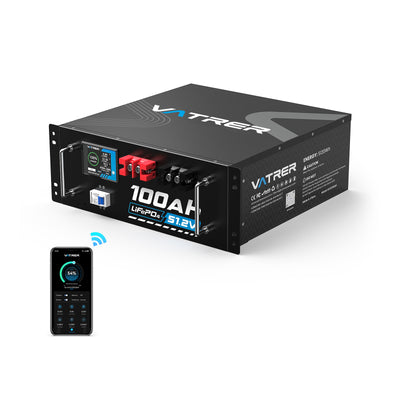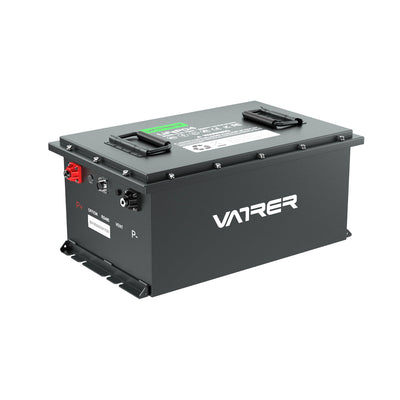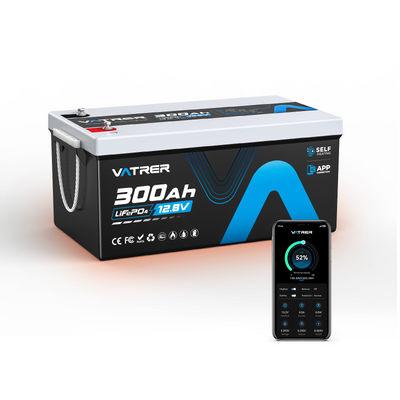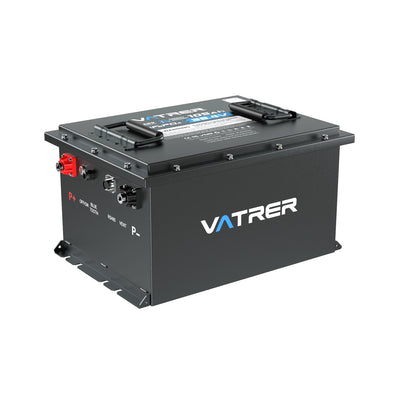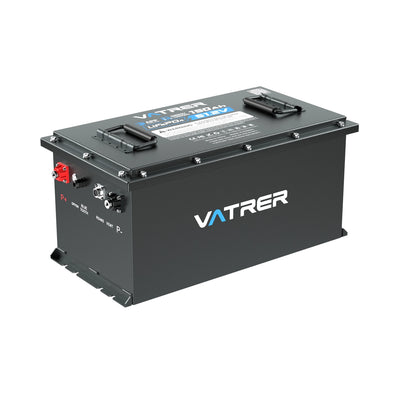
How To Charge a Deep Cycle Battery With Solar Panel
Using solar energy to power your RV, boat, or off-grid cottage is a smart and sustainable way to stay self-reliant. A deep-cycle solar battery, made to deliver steady energy output over time, works seamlessly with solar panels to store electricity for your travels and outdoor life.
By following a few clear steps, you’ll discover how to set up an efficient solar battery charging system for a deep-cycle battery. Let’s explore how to make the most of the sun’s renewable energy!

Understanding Deep Cycle Batteries for Solar Energy
Selecting the proper battery is the first step in creating a dependable solar charging setup. Deep-cycle batteries differ from car batteries—which deliver short, high bursts of power—because they are designed to be discharged and recharged repeatedly, making them ideal for renewable energy systems. Here’s an overview of the main categories:
| Battery Type | Cost | Lifespan | Maintenance | Environmental Impact | Best For |
|---|---|---|---|---|---|
| Lead-Acid (Flooded, AGM, Gel) | ~$260/kWh, more economical | 3–5 years (300–5,000 cycles) | Routine care (check water levels, clean terminals) | Contains lead, must be recycled safely | Fixed home solar installations |
| Lithium-Ion (LiFePO4) | ~$271/kWh, higher initial cost | 8–10 years (up to 4,000 cycles at 80% DOD) | Low maintenance, includes built-in Battery Management System (BMS) | Less hazardous, recyclable through special facilities | Portable or stationary use (RVs, boats, cabins) |
- Lead-Acid Batteries: Budget-friendly and durable, these units tend to be heavier (60–100 lbs for 100Ah) and require periodic maintenance like refilling water or cleaning corrosion. They’re suitable for stationary systems but need proper disposal due to lead content.
- Lithium-Ion Batteries: Vatrer 12V deep cycle solar batteries, particularly LiFePO4 models, are roughly one-third the weight of lead-acid options (about 25 lbs for 100Ah) and achieve up to 95% efficiency. Their BMS prevents overcharge, overheating, and cell imbalance, ensuring long-term reliability. Lithium batteries are also easier to recycle and have a smaller environmental footprint.
For solar setups, lithium-ion—especially LiFePO4—batteries are the best deep cycle batteries because they offer extended lifespan, portability, and almost maintenance-free operation. A 12V 200Ah deep-cycle battery like Vatrer’s can store 2,400Wh, enough to run appliances such as fridges and lighting systems.

How Solar Panels Charge Deep Cycle Batteries
Charging a deep-cycle battery through solar power involves converting sunlight into electrical energy and storing it safely. Here’s how the system works:
- Solar Panels: Photovoltaic (PV) modules capture sunlight and produce direct current (DC). Monocrystalline panels—up to 22% efficient—are the most productive for limited space setups.
- Charge Controller: Controls voltage and current to protect the battery and ensure stable charging.
- Solar Battery: Retains the energy for later use, like at night or on overcast days.
- Inverter (Optional): Converts stored DC power into alternating current (AC) for standard household electronics.
A 12V 100Ah battery holds 1,200Wh (100Ah × 12V). With a 150–200W solar panel, you can fully recharge it in 5–8 hours of good sunlight. However, shading from trees or nearby structures can lower efficiency by 50% or more, so proper placement is essential.
Thinking of upgrading your home’s solar system? Check this detailed guide: How much is a solar system for a 2000 sq ft house?

Why Charge Controllers Are Essential for Solar Charging
A charge controller is a vital component for safely charging deep-cycle batteries—especially with panels producing more than 5 watts. It prevents overvoltage and deep discharge, extending your battery’s lifespan. The main types include:
| Controller Type | Efficiency | Cost | Best For |
|---|---|---|---|
| MPPT (Maximum Power Point Tracking) | 93–97%, optimizes power harvest | Higher-end | Large systems, lithium batteries |
| PWM (Pulse Width Modulation) | Up to 60% energy loss | Lower cost | Smaller setups, lead-acid batteries |
| On/Off | ~85%, basic regulation | Least expensive | Low-power uses |
- MPPT Controllers: About 30% more efficient than PWM, perfect for lithium batteries that need accurate voltage. They adapt to light changes for consistent charging.
- PWM Controllers: Affordable but less efficient, best for basic lead-acid systems.
- On/Off Controllers: Outdated and rarely recommended, particularly for lithium batteries.
For a deep cycle solar battery, MPPT controllers are ideal—they ensure precise and safe charging, especially for advanced lithium-ion options like those from Vatrer.
Selecting the Right Solar Panel for Deep Cycle Charging
Choosing the correct solar panel for a deep cycle battery depends on capacity, sunlight exposure, and space. The three most common types include:
- Monocrystalline Panels: Compact, efficient (15–22%), and durable—ideal for RVs or marine applications.
- Polycrystalline Panels: Slightly less efficient (13–16%) but more affordable, suitable for larger ground systems.
- Thin-Film Panels: Flexible and light, excellent for portable setups but require more area (10–12% efficiency).
Key Considerations
- Wattage: A 12V 100Ah battery generally needs 150–200W to charge within 5–8 hours. A 12V 200Ah solar power deep cycle battery will require 300–400W.
- Sunlight Availability: In sunnier regions, 150–200W panels suffice; in overcast areas, 300W+ is better. To offset yearly efficiency loss (1–2%), oversize by 10–15%.
- Panel Position: Aim panels toward the sun between 10 a.m.–2 p.m., angled near your latitude ±15°. Avoid obstructions from trees or nearby structures.
Vatrer 12V deep cycle solar batteries work perfectly with 200W monocrystalline panels, providing consistent energy for your off-grid needs.
Setting Up a Solar Battery Charger for Deep Cycle Batteries
Building your solar battery charging system is straightforward with the correct tools:
- Select Equipment: Choose a 150–400W panel, an MPPT charge controller, and a solar lithium-ion battery. For bigger systems, connect panels in series or parallel to increase voltage or capacity. Vatrer 12V deep cycle batteries support 4P4S setups. For larger installations, consider 48V batteries such as 51.2V 100Ah rack-mounted or 200Ah wall-mounted models.
- Install Controller: Mount it in a dry, protected area. Connect solar input leads using MC4 connectors.
- Connect Battery: Attach output cables securely using Anderson plugs or ring terminals, matching polarity (red = positive, black = negative).
- Position Panels: Set them under full sunlight, tilted near your latitude ±15°. Keep surfaces clean.
- Monitor Progress: Verify voltage (14.4V–14.6V for 12V LiFePO4) using the controller or app. Vatrer’s BMS safeguards charging stability.
- Safety Check: Confirm all wiring is secure, avoid reverse polarity, and ground your system properly.
Note: Skipping a controller can severely shorten battery life or cause damage.
Best Practices for Solar Charging a Deep Cycle Battery
To get the most out of your deep cycle solar battery, follow these best practices:
- Clean Panels Regularly: Remove dirt every 1–2 months; grime can cut output by up to 20%. Adjust tilt with the seasons.
- Monitor Battery Performance: Vatrer solar batteries include Bluetooth-enabled BMS for real-time monitoring, helping prevent overcharging or imbalance.
- Control Temperature: Store between 0°C and 25°C. Use insulated boxes or heating pads in extreme cold and ventilation during heatwaves.
- Plan for Weather Changes: Cloudy days can reduce performance by 70–90%. Oversize your system by 20% or use a portable backup like a Vatrer power station.

Common Troubleshooting for Solar Battery Charging
When charging a deep-cycle battery via solar, a few issues may appear — here’s how to handle them:
- Slow or No Charge: Inspect for debris, shading, or loose connectors. Confirm your panel wattage suits the battery’s needs (150W+ for 100Ah).
- Overcharging: Quality MPPT controllers prevent this. Swelling or heat indicates a malfunction; replace faulty components.
- Rapid Discharge: Use a voltmeter to test. For Vatrer LiFePO4 batteries, BMS error messages can highlight cell issues—check the manual or contact support.
- Connection Faults: Look for corrosion and confirm correct polarity. Short circuits can damage the controller or BMS.
Conclusion
Charging a deep cycle battery using solar panels is an affordable and sustainable power solution for off-grid living. With the right combination of a top-quality deep cycle battery, MPPT controller, and efficient panels—like Vatrer’s LiFePO4 range—you can enjoy reliable power anywhere.
Follow good maintenance practices, monitor with BMS tools, and make small seasonal adjustments to maintain peak performance. Choose Vatrer batteries for reliable, Canadian-weather-ready solar power you can depend on.
Planning to invest in a high-performance solar battery? Review the following resources to help you decide:


































